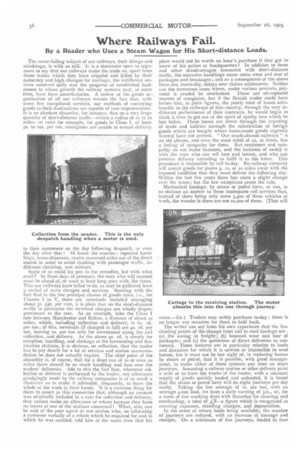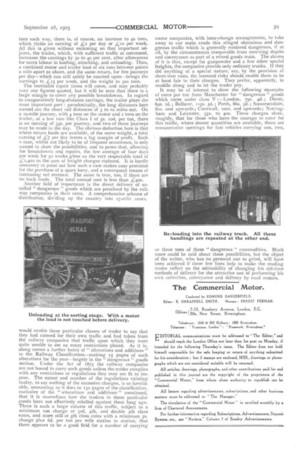Where Railways Fail.
Page 6

Page 7

If you've noticed an error in this article please click here to report it so we can fix it.
By a Reader who Uses a Steam Wagon for His Short-distance Loads.
The never-failing subject of our railways, their doings and misdoings, is with us still IL is a statement open to argument to say that our railways make the trade as, apart from those trades which they have crippled and killed by their autocracy and high charges for carriage, the indifferent services rendered daily mar the progress of established businesses to whose growth the railway systems may, at some time, have been contributories. A review of the goods organisation of all our railways reveals the fact that, with some few exceptional services, our methods of conveying goods to their destinations are capable of vast improvements. It is an absolute absurdity, for instance, that on a very large quantity of short-distance traffic—within a radius of Jo to zo miles—at rates for example, for goods in Class I, of from 5s. to /cis, per ron, consignors are unable to ensure delivery to their customers on the day following despatch, or even the day after that ! All know the reasons : repeated handlings, trans-shipment, routes traversed miles out of the direct course in order to avoid clashing with passenger traffic, indifferent checking, and mislays.
Some of us could lay pen to the remedies, but with what avail? In these days of pressure, the man who will succeed must be ahead of, or must at least keep pace with, the times. This our railways have failed to do, as may be gathered from a recital of some charges and services. Starting with the fact that in the five principal classes of goods rates, i.e., for Classes I to V, there are terminals included averaging about 55. 5id. per rate, it is plain that on the short-distance traffic in particular the terminal charges are wholly disproportionate to the rate. As an example, take the Class I rate between Manchester and Bolton, a distance of about, ro miles, which, including collection and. delivery, is 6s. rd. per ton; of this, terminals (if charged in full) are 45. rd. per ton, leaving 25. per ton only for conveyance along the rail collection, and delivery. As the above 45. rd. is simply for reception, handling, and clerk-age at the forwarding and destination stations, it is obvious, on reflection, that the trader has to pay dearly for a lot of services and station accommodation he does not actually require. The chief point of the absurdity is, of course, that for a short run of It) or even 20 miles there should be so much handling and fuss over the traders' deliveries. Add to this the fact that, whenever collection or delivery is performed by the trader, any allowance grudgingly made by the railway companies is of so small a character as to make it advisable, frequently, to leave the whole of the work in their hands. It is a common thing for them to assert in this connection that, although an amount was originally included in a rate for collection and delivery, they cannot make an allowance or rebate because they have no teams at one of the stations concerned ! What, also, can be said of the poor agent at one station who, on informing a customer verbally of a rebate which he enquired for and to which he was entitled, told him at the same time that his place would not be worth an hour's purchase if they got to know of his action at headquarters? In addition to these and other disadvantages connected with short-distance traffic, the excessive handlings cause extra wear and tear of packages and breakages; arid as a consequence of the above there are, inevitably, delays over claims settlements. Neither can the numerous cases where, under various pretexts, payment is evaded be overlooked. These are oft-repeated sources of complaint, but if the British trader could have before him, in plain figures, the yearly total of losses attributable to the railways of this country, through the very indifferent performance of their contracts, he would begin to think it time to get out of the spirit of apathy int.° which he has fallen. These losses are direct through the impeding of trade and indirect through the substitution of foreign goods which are bought where home-made goods urgently wanted have not arrived. " Our much-abused railways" Is an old phrase, and even the most rabid of us, at times, has a feeling of sympathy for them. But sentiment and sympathy do not make business, and the business of to-day is with the man who can sell best and lowest, and who can promise delivery intending to fulfil it to the letter. This procedure is impossible by rail to-day. No railway company will accept goods for places 5, mu, or 20 miles away with the imposed condition that they inert deliver the following day. Within the last few years there has come a slight change cn:er the scene ; but the few exceptions prove the rule.
Mechanical haulage, by steam or petrol lorry, or van, is so obvious an answer to these inadequate rail services that, instead of there being only some 3,500 of these vehicles at work, the wonder is there are not 20,000 of them. [That will come.—En.] Traders may safely purchase to-day there is no longer any occasion for them to hold back.
The writer can say from his own experience that the fascinating points of the change from rail to road haulage are (a) the saving in freight; (b) lessened wear and tear of packages; and (c) the quickness of direct deliveries to custamers. These features are in particular relation to loads and distances for which it is unwise or impossible to send horses, but it must not be lost sight of, in replacing horses by steam or petrol, that it is possible, with good management, to make either of these systems pay even on short journeys. Assuming a railway station or other delivery point a mile or so from the works of the trader, with a constant supply of goods quickly loaded and unloaded, it is found that the steam or petrol lorry will do eight journeys per day easily, Taking the low average of is. per ton, with an average 4-ton load, we have a daily earning of 325., or, for a week of live working days with Saturday for cleaning and overhauling, a total of .4:8—a figure which is recognised as covering expenses, standing charges, and depreciation.
In the event of return loads being available, the number of journeys are reduced, with an increase of tonnage and receipts. On a minimum of five journeys, loaded to four tons each way, there is, of cow se, an increase to 40 tons, which yields an earning of La per day or hi° per week. All this is given without reckoning on that important adjunct, the trailer, which, with sufficient traffic at command, increases the earnings by 30 to 40 per cent, after allowances for extra labour in loading, attaching, and unloading. Thus, a combined motor and trailer load of six tons between points a mile apart as above, and the same return, for five journeys per day—which can still safely be counted upon—brings the earnings to Lis per week, and the weight to 300 tons.
The inevitable repair times will come, and may probably vary any figures quoted, but it will be seen that there is a large margin to cover any possible breakdowns. In regard to comparatively long-distance carriage, the trailer plays the most important part : paradoxically, the long distances here named are the short rail distances of 5 to 20 miles out. On a ro-mile journey, with 4 tons on the motor and 2 tons on the trailer, at a low rate like Class I of ss. rod, per ton, there is an earning of 355. per journey, and two of these journeys may be made in the day. The obvious deduction here is that where return loads are available, of the same weight, a total earning of .4;7 per day leaves a big margin of profit. Such a case, whilst not likely to be of frequent occurrence, is only named to show the possibilities, and to prove that, allowint for breakdowns and repairs, the low average of four days per week for 50 weeks gives us the very respectable total of 41,400 as the sum of freight charges replaced. It is hardly necessary to point out how such a case makes easy provision for the purchase of a spare lorry, and a consequent means of increasing net revenue. The same is true, too, if there are no back loads. The total annual cost is less than ,400. Another field of importance is the direct delivery of socalled " dangerous " goods which are penalised by the railway companies in their rates. A comprehensive scheme of distribution, dividing up the country into 25-mile zones,
would enable these particular classes of trader to say that they had catered for their own traffic and had taken from the railway companies that traffic upon which they were quite unable to see so many restrictions placed. As it is, along comes a further batch of "alterations and additions" to the Railway Classification—making 25 pages of such alterations for the year—largely in the "dangerous " goods section. Under the Act of 1875 the railway companies are not bound to carry such goods unless the trader complies with any restrictions orregulations they may see fit to impose. The extent and number of the regulations existing to-day, to say nothing of the excessive charges, is so formidable, amounting as it does to 130 pages of the classification, exclusive of the " alterations and additions " mentioned, that it is marvellous how the traders in these particular goods have not effectively rebelled against them long ago. There is such a large volume of this traffic, subject to a minimum ton charge at 3rd, 4th, and double 4th class rates, and more still at 5th class rates with a minimum 5s. charge plus 6d. per ton per mile station to station, that there appears to be a good field for a number of carrying motor companies, with inter-change arrangements, to take away to our main roads this alleged obnoxious and dangerous traffic which is generally rendered dangerous, if at all, by the circumstances inseparable from receiving depots and conveyance as part of a mixed goods train. The shame of it is that, except for gunpowder and a few other special freights, the companies provide only ordinary trucks. If they did anything of a special nature, say, by the provision of sheet-iron vans, the lessened risks should enable them to be at least fair in their charges. They prefer, apparently, to muddle along and to let the trader pay. It may be of interest to show the following examples of rates per ton from Manchester for "dangerous " goods which come under class V :—London, 79s. 4d.; Dover, 89s. Ballater, i mss. 5d.; Perth, 86s. 3d.; Sornersetshire, 80s. and upwards; Cornwall, loos, and upwards; Nottingham and Leicester, 355. to 405. These charges show, roughly, that for those who have the courage to cater fot this traffic, where decent quantities are available, there are remunerative openings for fast vehicles carrying one, two, Or three tons of these "dangerous " commodities. Much more could be said about these possibilities, but the object of the writer, who has no personal axe to grind, will have been achieved if these few lines help to make the reading trader reflect on the advisability of changing his old-time methods of delivery for the attractive one of performing his own collection, conveyance and delivery by road motors.
















